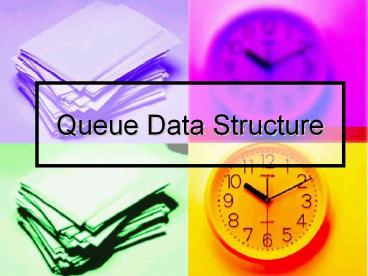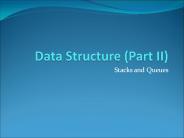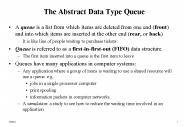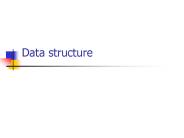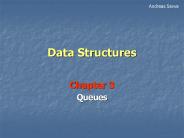Queue Data Structure - PowerPoint PPT Presentation
Title:
Queue Data Structure
Description:
Queue Data Structure What is queue? A queue is a linier data structure. The concept is quite similar with stack. additions are made at the end or tail of the queue ... – PowerPoint PPT presentation
Number of Views:8143
Avg rating:3.0/5.0
Title: Queue Data Structure
1
Queue Data Structure
2
What is queue?
- A queue is a linier data structure. The concept
is quite similar with stack. - additions are made at the end or tail of the
queue while removals are made from the front or
head of the queue. - Access system a queue is referred to a FIFO
structure (First-In First-Out)
3
Queue operations
- Add adds a new node
- Add(X,Q) ? add the value X to the tail of queue
- Remove removes a node
- Remove(Q) ? removes the head node and returns
its value - IsEmpty reports whether the queue is empty
- IsEmpty(Q) ? report whether the queue Q is empty
- IsFull reports whether the queue is full
- IsFull(Q) ? report whether the queue Q is full
- Initialize creates/initializes the queue
- Initialize(Q) ? create a new empty queue named Q
- Destroy deletes the contents of the queue (may
be implemented by re-initializing the queue) - Destroy(Q) ? deletes the contents of the queue Q
4
Illustration/example
- Operation
Queues contents
Return value
1. Initialiaze(S) ltemptygt -
2. Add(A,Q)
A
-
3. Add(B,Q)
A B
-
4. Add(C,Q)
A B C
-
5. Remove(Q)
B C
A
6. Add(D,Q)
B C D
-
7. Remove(Q)
C D
B
8. Remove(Q)
D
C
9. Remove(Q)
ltemptygt
D
5
Exercise Queue Operation
- What would the contents of a queue be after the
following operations? - Initialise(Q)
- Add(A,Q)
- Add(F,Q)
- Add(X,Q)
- Remove(Q)
- Add(B,Q)
- Remove(Q)
- Remove(Q)
- ? B
6
Storing a queue in a static data structure
- This implementation stores the queue in an array.
- The array indices at which the head and tail of
the queue are currently stored must be
maintained. - The head of the queue is not necessarily at index
0. The array can be a circular array the
queue wraps round if the last index of the
array is reached. - Example storing a queue in an array of length 5
7
Storing a queue in a static data structure (2)
Continue the above example to show the state of
the queue after the following operations Add(E,Q
) Remove(Q) Add(W,Q) Add(J,Q) Add(K,Q) What
happens at the last of these steps?
8
Storing a queue in a dynamic data structure
- Each node in a dynamic data structure contains
data AND a reference to the next node. - A queue also needs a reference to the head node
AND a reference to the tail node. - The following diagram describes the storage of a
queue called Queue. Each node consists of data
(DataItem) and a reference (NextNode).
- The first node is accessed using the name
Queue.Head. - Its data is accessed using Queue.Head.DataItem
- The second node is accessed using
Queue.Head.NextNode - The last node is accessed using Queue.Tail
9
Adding a node (Add) in a dynamic data structure
- The new node is to be added at the tail of the
queue. The reference Queue.Tail should point to
the new node, and the NextNode reference of the
node previously at the tail of the queue should
point to the DataItem of the new node.
10
Removing a node (Remove) in a dynamic data
structure
- The value of Queue.Head.DataItem is returned. A
temporary reference Temp is declared and set to
point to head node in the queue (Temp
Queue.Head). - Queue.Head is then set to point to the second
node instead of the top node. - The only reference to the original head node is
now Temp and the memory used by this node can
then be freed.
11
Queue Implementation
12
Queue Implementation in Java
- The Java Collections Framework in the most recent
version of Java now includes queue classes. - As you did for the stack, you will create your
own Queue class in order to learn how a queue is
implemented. - Your class will again be a bit simpler than the
Collections Framework one but it will do
essentially the same job
13
The Queue Class
- Since you implemented your stack as a static
structure, you will learn how to implement a
dynamic structure for your Queue
- The nodes of the queue will represented by
instances of a class Node. This holds a data item
of type Object, and a reference to the next Node.
The data item can contain any kind of Java
object. - The Queue class has references to two Nodes, the
head and the tail. The constructor sets these
references to be null as there are no Nodes
initially. - The Queue does not have a fixed size, so it will
never be full (unless the computer runs out of
memory). The isFull method simple returns false
here.
14
The Queue Class (2)
- Node.Java
- / class Node./
- public class Node
- Object dataItem
- Node nextNode
- Queue.Java
- / class Queue /
- public class Queue
- public Node head
- public Node tail
/ Constructor for objects of class Queue /
public Queue() // initialise head
and tail references head null
tail null / sets all queue
entries to null / public void destroy()
Node temp new Node() Node
setNull new Node() temp head
while (temp!null)
setNull temp temp
temp.nextNode setNull null
head null tail
null
15
The Queue Class (3)
/ checks whether queue is full not properly
implemented here / public boolean
isFull() return false
- / checks whether queue is empty/
- public boolean isEmpty()
- return head null
/ remove an item by obeying FIFO rule /
public Object remove() if
(head null) return null
else Node temp new
Node() temp head
head head.nextNode if (head
null) tail null return
temp.dataItem
/ add an item to the queue / public void
add(Object o) Node newNode new
Node() newNode.dataItem o
if (tail null) head
newNode tail newNode
else
tail.nextNode newNode tail
newNode
16
The Queue Class (4)
/ returns the number of items in the queue /
public int size()
int count 0 for (Node
currentheadcurrent!null
currentcurrent.nextNode) count
return count
17
Using a Queue
- To use the Queue class, you need to know how to
write code to call the Queue operations, for
example to add data to the Queue. - Remember that the Queue can hold any kind of
data. The following test class shows how to use a
Queue to hold String objects. - /
- /
- /class QueueTester. /
- public class QueueTester
- private Queue queue
- public QueueTester()
- queue new Queue()
- public QueueTester(Queue queue)
- this.queue queue
void addString(String str) void
removeString() void checkIfEmpty() void
listStringsInQueue()
18
Using a Queue (2)
/ check if queue is empty / public void
checkIfEmpty() if (queue.isEmpty())
System.out.println("Queue empty")
else System.out.println("Queue is not
empty") / list the strings in queue
/ public void listStringsInQueue()
if (queue.isEmpty())
System.out.println("Queue empty")
else System.out.println("Strings
in queue are ") System.out.println()
Node node queue.head
while (node ! null) String item
(String)node.dataItem
System.out.println(item) node
node.nextNode
System.out.println()
- / add item to queue /
- public void addString(String str)
- queue.add(str)
- System.out.println("Added new string")
- / remove item from queue /
- public void removeString()
- String result (String) queue.remove()
- if (result!null)
- System.out.println("String is "
result) - else
- System.out.println("Remove was
unsuccessful")
19
Exercise Using a Queue
- Create a new BlueJ project called queues and
create new classes Node, Queue and QueueTester
using the above code. - Create a new instance of Queue.
- Create a new instance of QueueTester and select
your Queue instance in the object bench as the
parameter in the constructor. This means that you
will be testing the Queue you created in the
previous step. - Call the checkIfEmpty method of your QueueTester.
- What was the result?
- Call the addString method of your QueueTester to
add the string The to the queque. - Repeat this to add the following strings
queue, gets, longer - What result would you expect if you remove from
the Queue? - Call the removeString method of your QueueTester
and check that you got the correct result. - Call the add method of your QueueTester to add
the strings every and day to the queue. - What do you expect the contents of the Queue to
be now? - Inspect your Queue object. You should see
references to the head and tail of the Queue.
20
For Your EXERCISE Storing other types of data
- Modify the QueueTester class to store Double
objects in a Queue instead of String objects, and
test in a similar way to the above. - You should not have to change the Queue class at
all.
21
EXERCISE A practical application of the Queue
class
- A queue is a useful data structure for holding
data which should be processed in the order it is
created, but which cannot always be processed
straight away. A typical application might be a
messaging system. In the following example,
messages are received in the order they were
sent. - The classes involved are Message, MessageSender
and MessageReceiver - A Message object has a sender, a recipient, a
content string and a date. - A Message is placed in a Queue by a MessageSender
object. - A Message is removed from the queue by a
MessageReceiver object, which can also display
the contents of the Queue. - The Queue class you have created in this chapter
can hold any type of object, including Messages,
so you can use it in this example as it is. - Add the following classes to your queues project
22
EXERCISE A practical application (the code)
- Message.Java
- import java.text.
- import java.util.Date
- / class Message /
- public class Message
- public String sender
- public String recipient
- public String content
- public Date date
- /Constructors for objects of class Message /
- public Message()
- this.sender "unknown sender"
- this.recipient "unknown recipient"
- this.content "none"
- this.date new Date()
23
EXERCISE A practical application (the code)
- MessageSender.Java
- /class MessageSender. /
- public class MessageSender
- / places a message on a specified queue /
- public void sendMessage(String sender, String
recipient, String content, Queue q) - Message m new Message(sender,
recipient, content) - if(!q.isFull())
- q.add(m)
- System.out.println("Message placed on
queue") - else
- System.out.println("Cannot send -
queue is full")
24
EXERCISE A practical application (the code)
- MessageReceiver.Java
- / class MessageReceiver /
- public class MessageReceiver
- / receives and outputs a message from a
specified queue / - public void receiveMessage(Queue q)
- Message m (Message) q.remove()
- if (m ! null)
- System.out.println("Date "
m.getDate()) - System.out.println("From "
m.sender) - System.out.println("To "
m.recipient) - System.out.println("Content "
m.content) - else
- System.out.println("No messages to
receive")
25
EXERCISE A practical application of the Queue
class (test sequence)
- Create new instances of MessageSender,
MessageReceiver and your Queue class - Use the MessageSender instance to add the
following messages to the queue - Sender Recipient Content
- Rudy Aini Assalamualaikum
- Rida Ahmad What does the mean?
- Hakiem Husein See you later
- Use the MessageReceiver instance to
- Display the queue contents
- Remove the first message in the queue
- Display the queue contents again
- Use appropriate methods to add the following
messages to the Queue, remove the first message
and display the queue contents again. - Sender Recipient Content
- Wildan Abdul Good Evening
- Diana Fikri Bye for now
- Use appropriate methods to remove the first
message and add the following message to the
Queue, and display the Queue contents again. - Sender Recipient Content
- Rizki Adinda I love you

